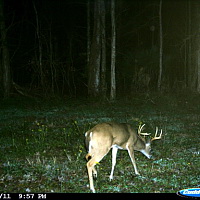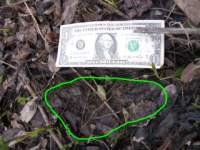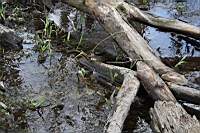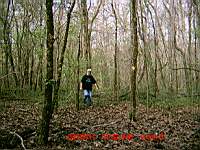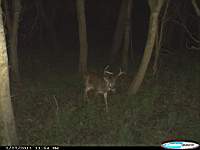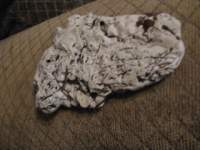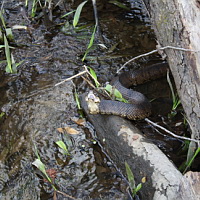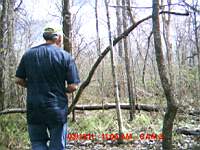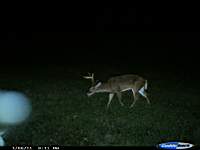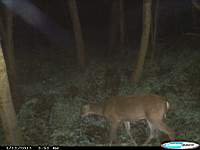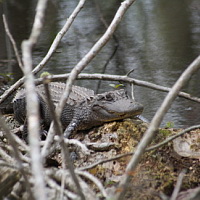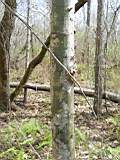March 10/11/12/13 2011 Louisiana Outing
 We returned to one of our many areas of interest in Louisiana for this weekend. Six researchers participated in this outing, 3 arrived on Thursday
to setup base camp, 2 arrived Friday and one independent researcher joined us on Saturday afternoon. One of the team members had come to this area
and had deployed 5 game cameras several weeks in advance of our outing to see if anything of interest could be captured. We also brought a new toy
with us this time called a Plot Watcher made by Day 6 Outdoors, this device takes pictures at designated intervals without the need to be triggered
and regardless of what might be in the picture. It takes pictues of a targeted area producing a time lapse video that allows you to review hours of
pictures in the space of a few minutes, so you can monitor what game has passed through an area, took bait or visited a feeder, etc. The device
only works during the day light hours and can be variably programmed to take pictures every 1-10 seconds. The picture of the Coyote to the right
was caught using this new device. Each of the researchers had 4-6 game cameras that they deployed for this weekend as they arrived with their equipment.
These included models made by Moultrie, Cuddeback, StealthCam and Bushnell.
We returned to one of our many areas of interest in Louisiana for this weekend. Six researchers participated in this outing, 3 arrived on Thursday
to setup base camp, 2 arrived Friday and one independent researcher joined us on Saturday afternoon. One of the team members had come to this area
and had deployed 5 game cameras several weeks in advance of our outing to see if anything of interest could be captured. We also brought a new toy
with us this time called a Plot Watcher made by Day 6 Outdoors, this device takes pictures at designated intervals without the need to be triggered
and regardless of what might be in the picture. It takes pictues of a targeted area producing a time lapse video that allows you to review hours of
pictures in the space of a few minutes, so you can monitor what game has passed through an area, took bait or visited a feeder, etc. The device
only works during the day light hours and can be variably programmed to take pictures every 1-10 seconds. The picture of the Coyote to the right
was caught using this new device. Each of the researchers had 4-6 game cameras that they deployed for this weekend as they arrived with their equipment.
These included models made by Moultrie, Cuddeback, StealthCam and Bushnell.
March 10, 2011
On Thursday March 10th, the research members began arriving and setup base camp and then quickly moved into deploying the Plot Watcher as well as 3 game cameras from noon to 14:00hrs in an area behind base camp that has generated a history of wood knocks and vocalizations. The goal for this night was to conduct themselves as normal campers, no attempts to overtly illicit any types of responses via call blasting or wood knocks would be attempted. Later in the evening at 19:40hrs the group left for 55 minutes to go deploy audio recorders in another location within the research area, prior to their departure an audio recorder had been left running at camp and was positioned in a tree behind one of the tents, it was well hidden from view. They returned and resumed normal activity at 20:35hrs, there were no other campers in the area on this night. Other than the deployment of the cameras and audio recorders everything else was conducted as normal campers, they built a fire, listened to music, talked, snacked, etc. The team turned in for the night around midnight, without hearing anything during this time that seemed out of the ordinary. The audio recordings from this night, when reviewed later, turned up some interesting stuff as a camp visitor was detected 10 minutes after their departure. At 19:50hrs something can be heard walking around camp and moves or perhaps tries to open storage boxes that had been left unattended in their absence, the visitor stays in camp until about 5 minutes prior to their return. This audio has been included for review below.
March 11, 2011
On Friday evening we had between 15-20 game cameras and at least that many audio recorders rolling in the research area which consists of over 17,000 acres of woods. For this night we split into 2 groups with one 2 man team road running and a 3 man team deploying as a static listening post in an area where wood knocks were recorded the year before. No attempts to illicit any type of response via call blasting or wood knocks were tried on this night. Only Possum and Raccoons were spotted by the road runner team as they drove around with camcorders rolling just in case. At 23:00 hours the team positioned as a listening post decided to quietly hike into the woods on a well used ATV trail. This area already had audio recorders deployed earlier in the afternoon, during this time the team did hear some limb snaps at 150-200 yards out, but couldn't see anything through the trees even with the aid of Gen2 night vision attached to a Digital 8 Sony camcorder. After an hour of listening the team decided to extract and allow the recorders in place to monitor activity for the rest of the night. The audio recorders were recovered the next morning and downloaded to laptops for later review. After having been reviewed over the ensuing couple of weeks, some the interesting results from Friday night have been included below. These included 3 apparently bipedal walkup incidents at baited and camera monitored recording stations. The camera placement and distance to the bait had been carefully considered during setup, the camera's were placed so that anything in the target area would be well within the trigger sensing distance while at the same time the camera would be far enough away to make sure that there was no way to approach the bait without breaking into the cameras cone of detection. There is no way that something could have walked up and consumed the bait at 5-7 feet above the ground and hung around for many minutes while doing so and not have been in the field of view of the camera. In each case the cameras that were in place took pictures of the team upon our return to the location involved, the cameras made by Moultrie and Cuddeback for some reason failed to get a picture of the creature that you will hear in the audio links below but fired without fail on the team. Something is very strange with this outcome, we have a couple of theories, but they are just theories, we won't take the reader through those just yet as the fun was just beginning.
March 12, 2011
On Saturday we made the rounds to collect all of the audio recorders from Friday night while at the same time keeping an eye out for any evidence. We noticed that one of the recording locations from Friday night had the Peanut Butter nearly completely consumed the audio of this incident is included below. Some of the game cameras were also repositioned as part of the audio recovery process. We also changed up some of the bait being used and replaced the Peanut Butter with Hotdogs, the Hotdogs proved to be very effective as bait as well. At one of the recording locations for this evening we speared a Hotdog on to the end of a short limb that was about 5 feet off the ground, then cut another Hotdog into pieces and threw those around the target tree, a game camera was placed about 20 feet away to make sure that anything entering the area of any size would not be able to enter the area of the bait without also breaking into the cameras cone of detection. On Sunday morning all signs of the Hotdogs were gone, the audio of what happened to them is provided below. The camera did not photograph the bipedal sounding thief.
Saturday afternoon we were joined by a sixth researcher, he brought his call blaster which is designed to push calls out over a very wide area of several miles if desired. We have confirmed via remote audio recorders on previous outings that this call blaster can be heard over 6 miles away if conditions are good. Some scouting in the area 60 yards behind base camp revealed a set of 6 inch impressions that appeared to display some toes. We decided to make an attempt at casting the impression which did preserve the toes but the photos which we include below do not show it well. For our operations on Saturday night we planned to include some call blasting at two predetermined locations. We separated into a call blasting team and a listening team. The listening team arrived and began to setup at 23:00hrs, the call blast team arrived at location one a short time thereafter, which was on the other side of a Bayou and 1.8 miles Northeast of the listening team. We coordinated our efforts via text messaging on our phones and by 23:30hrs we were ready to send out the first call at reduced volume. The calls were directed to the West and Southwest of the call blast location. This is an area that encompasses serveral miles of unbroken forest. Unidentifed vocals, wood knocks and walkup recordings have been captured from this area in years past. Call blasting has been tried by the team before in the area with mixed success and this night would prove to be rather tame. Several calls were tried including howls from Washington, the Ohio howl and some howls that we have recorded from various research locations. Nothing responded during the time that we spent at location one, so the call blast team moved to a location that was much closer to the listening team so that we were now only separated by about 1/2 mile. At location number 2 we did manage to kickoff a couple of coyote packs but nothing else of interest responded. Since only coyotes were responding to our calls we tried a couple of wood knocks but nothing was detected in response to those. At 01:00 we decided to call off the overt attempts to illicit responses and return to base camp. Audio recording of base camp on this night resulted in several more incidents of something coming through our camp, we have included 2 of these in audio links below.
Discussion of Game Camera effectiveness
Here are some thoughts as to why a picture was not captured, we don't propose to know everything and we are not game camera engineers, but we have done some reading on PIR detection technology and how it is supposed to work. This outing and the audio recordings produced from it had at least a half dozen times where we think we very possibly had the target species (Sasquatch) in front of a game camera and have come away with no pictures. The issue involves several different camera manufacturers, and in all cases the camera's took pics of the research team upon recovery of the equipment. In every case in order to take a bait such as Peanut Butter (which is used precisely because the creature has to stay and work to extract from tree bark), from the target tree it must walk to a dead center location in front of the camera. There was no way to reach out and grab the bait while hiding behind another tree, etc. In addition, from listening to the audio it does not appear that any effort was made to keep a distance from the bait anyway.
This all leaves us with a problem to resolve, is the lack of a picture with a game camera a result of atmospheric conditions, physiology of the target species or a problem with the aim during camera setup? We feel that the last option was not the problem and we have provided a couple of pictures below to demonstrate. Atmospheric conditions can have an impact on how well the PIR can detect a moving heat source, the higher the ambient temperature the more difficult it will be to detect a source since the difference in temperature between the source and the background is less. This will reduce the detection distance, however, on the nights in question the ambient temps were 40-50F degrees. This would result in very solid heat signatures and as a result good detection distances. Not to mention that the cameras had no trouble firing on us when the day time temps were a good bit higher. This leaves possible characteristics of the creature itself, two theories that we have tossed around are the amount and thickness of hair coverage on the body and the normal body temperature of the target. Unlike a Thermal camera which simply displays the difference in temperature between objects in the view (either in gray scale or color), a game camera is set to trigger on a temperature range. This is done to make the camera selective and to keep the camera from firing on all temp differences which would result in constant false positives and endless pictures of nothing.
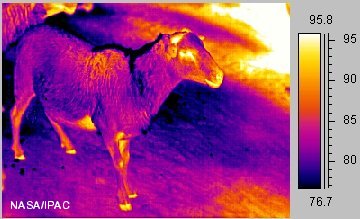 Most PIR detection systems are setup to detect heat signals from 8-12 micrometers, which covers most mammals and birds. Birds having
the highest body temps detectable at the high end of this range, humans have a heat signature of around 10 micrometers. One thought
that we have had is what if our target species has a normal body temperature below the range that the camera is looking for, this
could result in an animal being able to walk around in front of a camera without being considered a positive target. The other thought
is what if the hair coverage could be heavy enough to cause the outer most hair to assume ambient temperature. Thus causing
a blanketing effect that conceals or masks most of the detectable heat that a game camera needs to be properly triggered.
Much like the thermal picture of a sheep to the right, which demonstrates the idea of the body heat being shielded by the hair
coverage and making much of it appear to be ambient temperature. These are a couple of ideas, for some reason game cameras are
having a very tough time producing Bigfoot/Sasquatch evidence and our audio is pointing to a possible problem in how these cameras
are currently engineered with regards to this research. If one of these ideas is correct it would go a long way in explaining why
with the thousands game cameras deployed in purported Bigfoot habitat there are no good pictures of one.
Most PIR detection systems are setup to detect heat signals from 8-12 micrometers, which covers most mammals and birds. Birds having
the highest body temps detectable at the high end of this range, humans have a heat signature of around 10 micrometers. One thought
that we have had is what if our target species has a normal body temperature below the range that the camera is looking for, this
could result in an animal being able to walk around in front of a camera without being considered a positive target. The other thought
is what if the hair coverage could be heavy enough to cause the outer most hair to assume ambient temperature. Thus causing
a blanketing effect that conceals or masks most of the detectable heat that a game camera needs to be properly triggered.
Much like the thermal picture of a sheep to the right, which demonstrates the idea of the body heat being shielded by the hair
coverage and making much of it appear to be ambient temperature. These are a couple of ideas, for some reason game cameras are
having a very tough time producing Bigfoot/Sasquatch evidence and our audio is pointing to a possible problem in how these cameras
are currently engineered with regards to this research. If one of these ideas is correct it would go a long way in explaining why
with the thousands game cameras deployed in purported Bigfoot habitat there are no good pictures of one.
